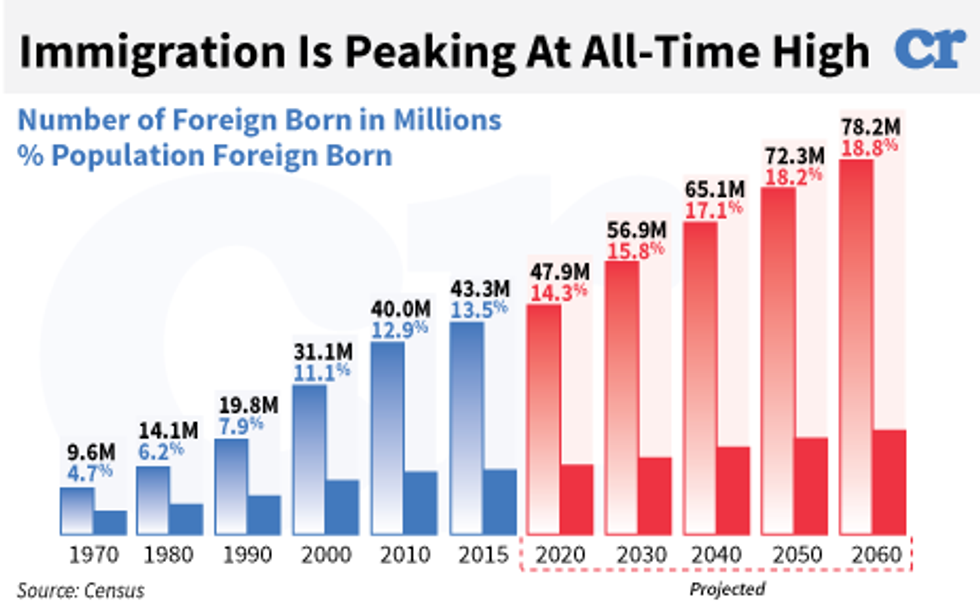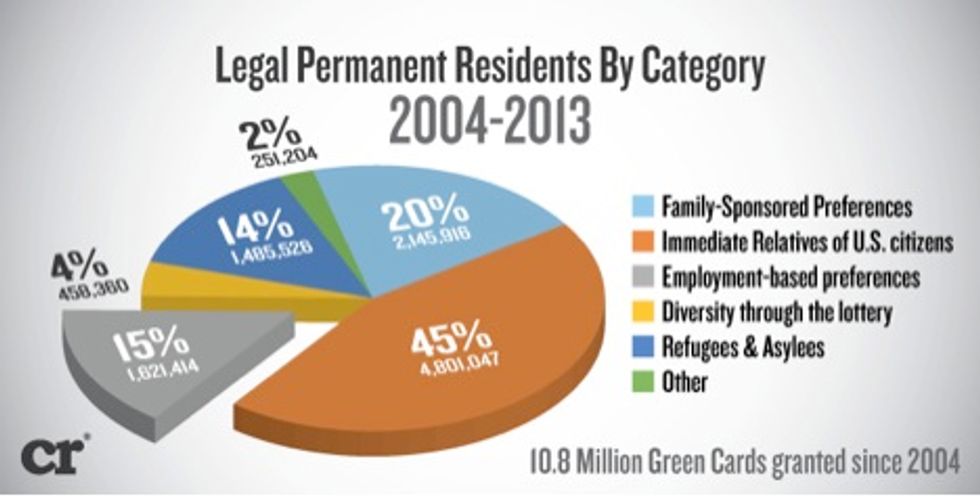
© 2024 Blaze Media LLC. All rights reserved.
For far too long, much as with health care reform, the Washington Cartel has hijacked the meaning of immigration reform. Until now, it has meant mass amnesty for illegal immigration, endless expansion of the current failed legal immigration system, and ignoring the needs of the American citizen.
Sens. Tom Cotton, R-Ark., and David Perdue, R-Ga., with the re-introduction of the RAISE (Reforming American Immigration for a Strong Economy) Act, have flipped the paradigm on its head. Most importantly, the White House is actually taking an active role in promoting this legislation — an imperative in promoting any conservative idea.
There is broad consensus among the public that immigration should a) be limited to those who have unique skills; b) cultivate the assimilation of American values and the English language; and c) that it should be a net positive for all Americans, not just the corporate-D.C. cartel.
This is the message Trump ran on, and it is the message that Cotton and Purdue have restored with this legislation (after a several-month detour by the White House). If the president continues to use the bully pulpit to sell this plan, he could go a long way toward staving off a looming disaster in the midterms and actually making the party stand for something important again.
The problem: The 1965 immigration bill
As I chronicle in detail of Chapter 7 of my book, “Stolen Sovereignty,” the 1965 immigration bill killed our immigration system long before illegal immigration and the 1986 amnesty became the dominant issues.
The Immigration and Nationality Act of 1965 was sold by its proponents as the exact opposite of what it has actually done. It was sold as in line with our history and tradition of only bringing in those who will patriotically assimilate and not become a drain on the public purse.
Sen. Ted Kennedy, the lead sponsor of the bill, famously declared, “The bill will not flood our cities with immigrants. It will not upset the ethnic mix of our society. It will not relax the standards of admission. It will not cause American workers to lose their jobs.” He thundered at a Senate hearing how “the bill will not permit the entry of subversive persons, criminals, illiterates, or those with contagious disease or serious mental illness” or “to a person who is likely to become a public charge.”
Sensing what the public wanted from immigration, the LBJ administration echoed a similar sentiment. Attorney General Nicholas Katzenbach predicted that the ’65 bill would induce a net increase of only about 60,000 immigrants per year.
A complete lie. The Immigration and Nationality Act of 1965 wound up being the most extreme policy implemented during the latter part of the 20th century, as measured against the criteria laid down by the bill’s own supporters. Here are some points from my book:
- Overwhelming numbers of immigrants: Whereas 18.2 million immigrants came during the Great Wave in 1890-1919, over 61 million immigrants have come since passage of the bill (not including illegal immigrants, who are largely influenced by the drive to reunite with relatives as a result of the record legal immigration.)
- Living in poverty:According to Pew, in 1970, 18 percent of immigrants were living below the poverty line. At present, 28 percent of immigrants are living in poverty. The poverty rate among natives, on the other hand, has held steady between 13 and 15 percent. More than 50 percent of all immigrant households receive welfare benefits, compared to only 30 percent of native households in the United States that receive welfare benefits.
- Dramatic shifts in countries of origin: What about the promise not to fundamentally change the orientation of the country? In 1910, 89 percent of immigrants were from Europe; today that number is just 10 percent. It’s not just a cultural transformation, it affects the economy as well. As of 2013, the median family income for immigrant families from Europe was $66,600, roughly twice the income of those from Mexico ($31,100), the Caribbean ($31,100), Africa ($34,800), and central/South America ($37,400). This, despite the fact that most of the recent job growth has gone to the immigrant population.
- Dramatic imbalance: What about Ted Kennedy’s promise that his bill would not “inundate America with immigrants from any one country or area?” Fifty percent of all immigrants since 1965 have come from Latin America — 29 percent from Mexico alone. According to the Pew Research Center, as of 2010, Mexicans were the largest immigrant group in thirty-three states, with immigrants from other Latin American countries winning first place in six other states. At the height of the first great wave in 1910, on the other hand, Germans held the distinction of the most represented immigrant group in just seventeen states.
- Criminal activity: What about criminals? There are 2.1 million illegal and legal immigrants convicted of crimes, but 1.2 million criminal aliens remain at large in the United States and have not been deported.
- Language assimilation problems: A record 63.2 million, or one in five U.S. residents, speak a language other than English at home. In six states, that number exceeds 30 percent and is as high as 44 percent in the state of California. Thirty-four of the major metropolitan areas in the country have a third or more residents who speak foreign languages at home; sixty-seven metropolitan areas top 25 percent in foreign-language speakers.
- California a canary in the coal mine: California demographics speak for themselves. Orange County was once the bread basket of GOP politics in the state and was a big part of the GOP’s dominance during the Nixon and Reagan eras. Thirty percent of the county’s population is now foreign-born and 45.5 percent of residents speak a foreign language at home.
As leading immigration historian Aristide Zolberg has observed, “Whether hailed or deplored, there is no gainsaying that this development was contrary to the tacit agreement to maintain immigration as a minor feature of American existence that underlay the 1965 reform.”
The new RAISE Act: What would it do?
The main problem of the 1965 bill, which was exacerbated by a 1990 immigration bill, is that it forced immigration officials to prioritize family ties over skills.
Thus, once the initial burst of immigrants was predominantly low-skilled and from third-world countries, it set off a phenomenon of “chain migration,” whereby the majority of future immigrants were from similar socio-economic backgrounds.
The result is that just 15 percent of our green cards (1.6 million of the 10.8 million legal permanent residents over the past decade) are allocated based on any skill, and most of those green cards are not awarded for broad-based skills and ability to assimilate — but rather in crony visa programs.
Which brings us back to the RAISE Act. This bill fulfills the blueprint I laid out in “Stolen Sovereignty” for cutting immigration by 40-50 percent by merely getting rid of the non-skilled, extended-family categories. By getting rid of the diversity visa lottery and extended-family visa preferences, this bill charts a path toward re-empowering Americans to determine who gets to join the civil society.
Deeply rooted in the preamble of the Declaration and in consent-based governance is that the citizenry must decide every important policy issue. And the most important decision is the future orientation of the society. Converting our system to a skills-based criterion rather than a family-based one will place the keys of our immigration system back in the hands of the citizenry rather than special interests and the immigrants themselves. It will end the stolen sovereignty.
On the employment side of the ledger, rather than submit the future of our society to individual corporations that lobby the most for visas, this bill would revamp the current visa system and replace it with 130,000 visas to be allocated based on a points system that prioritizes education, English-language proficiency, high-paying job offers, merit, and entrepreneurial initiative. Those with the most points will get first preference.
This system would completely cut out the cronyism and is the sort of holistic reform of immigration that many of us want for health care. When you appeal to broad common-sense principles and cut out the crony middlemen, the American people are empowered and much of the politics goes by the wayside.
On paper, even Jeb Bush, Marco Rubio, and an array of Democrats have said they want a system that is based on merit rather than family ties. Now is their time to back up their words. Do they really care about the immigration issue beyond the obsession with amnesty?
Thankfully, President Trump is leading on this issue and actually endorsing a good piece of legislation. He should deliver a special address before Congress laying out the vision and unite the party behind it. A united GOP (one could only dream!) behind this issue would open up an entirely new front in the 2018 midterms.
It’s time we stop ceding the ground of common-sense reform to those who seek to perpetuate the failed status quo.
Editor's note: This article has been updated to correct a typographical error.
Want to leave a tip?
We answer to you. Help keep our content free of advertisers and big tech censorship by leaving a tip today.
Want to join the conversation?
Already a subscriber?
Blaze Podcast Host
Daniel Horowitz is the host of “Conservative Review with Daniel Horowitz” and a senior editor for Blaze News.
RMConservative
Daniel Horowitz
Blaze Podcast Host
Daniel Horowitz is the host of “Conservative Review with Daniel Horowitz” and a senior editor for Blaze News. He writes on the most decisive battleground issues of our times, including the theft of American sovereignty through illegal immigration, theft of American liberty through tyranny, and theft of American law and order through criminal justice “reform.”
@RMConservative →more stories
Sign up for the Blaze newsletter
By signing up, you agree to our Privacy Policy and Terms of Use, and agree to receive content that may sometimes include advertisements. You may opt out at any time.
© 2024 Blaze Media LLC. All rights reserved.
Get the stories that matter most delivered directly to your inbox.
By signing up, you agree to our Privacy Policy and Terms of Use, and agree to receive content that may sometimes include advertisements. You may opt out at any time.





